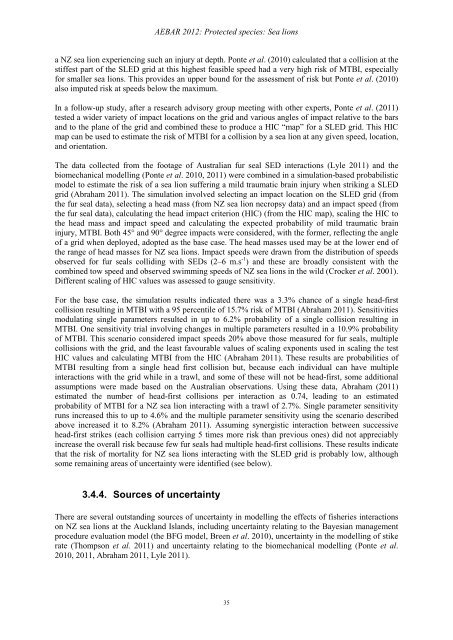Aquatic Environment and Biodiversity Annual Review 2012
Aquatic Environment and Biodiversity Annual Review 2012
Aquatic Environment and Biodiversity Annual Review 2012
You also want an ePaper? Increase the reach of your titles
YUMPU automatically turns print PDFs into web optimized ePapers that Google loves.
AEBAR <strong>2012</strong>: Protected species: Sea lions<br />
a NZ sea lion experiencing such an injury at depth. Ponte et al. (2010) calculated that a collision at the<br />
stiffest part of the SLED grid at this highest feasible speed had a very high risk of MTBI, especially<br />
for smaller sea lions. This provides an upper bound for the assessment of risk but Ponte et al. (2010)<br />
also imputed risk at speeds below the maximum.<br />
In a follow-up study, after a research advisory group meeting with other experts, Ponte et al. (2011)<br />
tested a wider variety of impact locations on the grid <strong>and</strong> various angles of impact relative to the bars<br />
<strong>and</strong> to the plane of the grid <strong>and</strong> combined these to produce a HIC “map” for a SLED grid. This HIC<br />
map can be used to estimate the risk of MTBI for a collision by a sea lion at any given speed, location,<br />
<strong>and</strong> orientation.<br />
The data collected from the footage of Australian fur seal SED interactions (Lyle 2011) <strong>and</strong> the<br />
biomechanical modelling (Ponte et al. 2010, 2011) were combined in a simulation-based probabilistic<br />
model to estimate the risk of a sea lion suffering a mild traumatic brain injury when striking a SLED<br />
grid (Abraham 2011). The simulation involved selecting an impact location on the SLED grid (from<br />
the fur seal data), selecting a head mass (from NZ sea lion necropsy data) <strong>and</strong> an impact speed (from<br />
the fur seal data), calculating the head impact criterion (HIC) (from the HIC map), scaling the HIC to<br />
the head mass <strong>and</strong> impact speed <strong>and</strong> calculating the expected probability of mild traumatic brain<br />
injury, MTBI. Both 45° <strong>and</strong> 90° degree impacts were considered, with the former, reflecting the angle<br />
of a grid when deployed, adopted as the base case. The head masses used may be at the lower end of<br />
the range of head masses for NZ sea lions. Impact speeds were drawn from the distribution of speeds<br />
observed for fur seals colliding with SEDs (2–6 m.s -1 ) <strong>and</strong> these are broadly consistent with the<br />
combined tow speed <strong>and</strong> observed swimming speeds of NZ sea lions in the wild (Crocker et al. 2001).<br />
Different scaling of HIC values was assessed to gauge sensitivity.<br />
For the base case, the simulation results indicated there was a 3.3% chance of a single head-first<br />
collision resulting in MTBI with a 95 percentile of 15.7% risk of MTBI (Abraham 2011). Sensitivities<br />
modulating single parameters resulted in up to 6.2% probability of a single collision resulting in<br />
MTBI. One sensitivity trial involving changes in multiple parameters resulted in a 10.9% probability<br />
of MTBI. This scenario considered impact speeds 20% above those measured for fur seals, multiple<br />
collisions with the grid, <strong>and</strong> the least favourable values of scaling exponents used in scaling the test<br />
HIC values <strong>and</strong> calculating MTBI from the HIC (Abraham 2011). These results are probabilities of<br />
MTBI resulting from a single head first collision but, because each individual can have multiple<br />
interactions with the grid while in a trawl, <strong>and</strong> some of these will not be head-first, some additional<br />
assumptions were made based on the Australian observations. Using these data, Abraham (2011)<br />
estimated the number of head-first collisions per interaction as 0.74, leading to an estimated<br />
probability of MTBI for a NZ sea lion interacting with a trawl of 2.7%. Single parameter sensitivity<br />
runs increased this to up to 4.6% <strong>and</strong> the multiple parameter sensitivity using the scenario described<br />
above increased it to 8.2% (Abraham 2011). Assuming synergistic interaction between successive<br />
head-first strikes (each collision carrying 5 times more risk than previous ones) did not appreciably<br />
increase the overall risk because few fur seals had multiple head-first collisions. These results indicate<br />
that the risk of mortality for NZ sea lions interacting with the SLED grid is probably low, although<br />
some remaining areas of uncertainty were identified (see below).<br />
3.4.4. Sources of uncertainty<br />
There are several outst<strong>and</strong>ing sources of uncertainty in modelling the effects of fisheries interactions<br />
on NZ sea lions at the Auckl<strong>and</strong> Isl<strong>and</strong>s, including uncertainty relating to the Bayesian management<br />
procedure evaluation model (the BFG model, Breen et al. 2010), uncertainty in the modelling of stike<br />
rate (Thompson et al. 2011) <strong>and</strong> uncertainty relating to the biomechanical modelling (Ponte et al.<br />
2010, 2011, Abraham 2011, Lyle 2011).<br />
35

















